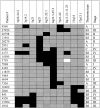Thymic epithelial tumors can develop along two different pathogenetic pathways
- PMID: 11696445
- PMCID: PMC1867047
- DOI: 10.1016/s0002-9440(10)63031-3
Thymic epithelial tumors can develop along two different pathogenetic pathways
Abstract
To investigate genetic abnormalities associated with the development of thymic epithelial tumors, we performed microsatellite analysis of 26 thymomas belonging to three different World Health Organization types (A, B3, and C) using 48 repeats. The most frequent aberration seen was loss of heterozygosity (LOH) in the region 6q23.3-25.3 detected in 11 tumors (45.8% of informative cases). Further consistent LOHs were detected in regions 3p22-24.2, 3p14.2 (FHIT gene locus), 5q21 (APC), 6p21, 6q21-22.1, 7p21-22, 8q11.21-23, 13q14 (RB), and 17p13.1 (p53). Microsatellite instability was extremely rare, occurring in one type B3 thymoma only, although, at 12.5% of the analyzed loci. Comparing the allelotypes of the analyzed thymomas, we were able to identify two pathogenetic pathways these tumors develop along, characterized by the 6q23.3-25.3 and 5q21 LOHs, respectively. The APC aberration on 5q21 showed significant associations with LOH in the 3p22-24.2, 13q14, and 17p13.1 regions. Interestingly, type A thymomas presented with consistent LOH in the region 6q23.3-25.5 only, they did not reveal any aberrations in the APC, RB, and p53 gene loci or regions 3p22-24.2 and 8q11.21-23. The absence of these aberrations might be the reason for the well-known benign behavior of type A thymomas as compared to types B3 and C tumors.
Figures




References
-
- Harris NL, Muller-Hermelink HK: Thymoma classification. A siren’s song of simplicity. Am J Clin Pathol 1999, 112:299-303 - PubMed
-
- Kornstein MJ: Thymoma classification: my opinion. Am J Clin Pathol 1999, 112:304-307 - PubMed
-
- Suster S, Moran CA: Thymoma classification. The ride of the valkyries? Am J Clin Pathol 1999, 112:308-310 - PubMed
-
- Rosai J, Sobin LH: Histological typing of tumors of the thymus. Rosai J Sobin LH eds. WHO International Histological Classification of Tumors. 1999, :pp 1-65 SpringerVerlag, Berlin
-
- Müller-Hermelink HK, Marx A: Pathological aspects of malignant and benign thymic disorders. Ann Med 1999, 31(Suppl 2):S5-S14 - PubMed
Publication types
MeSH terms
LinkOut - more resources
Full Text Sources
Medical
Research Materials
Miscellaneous

